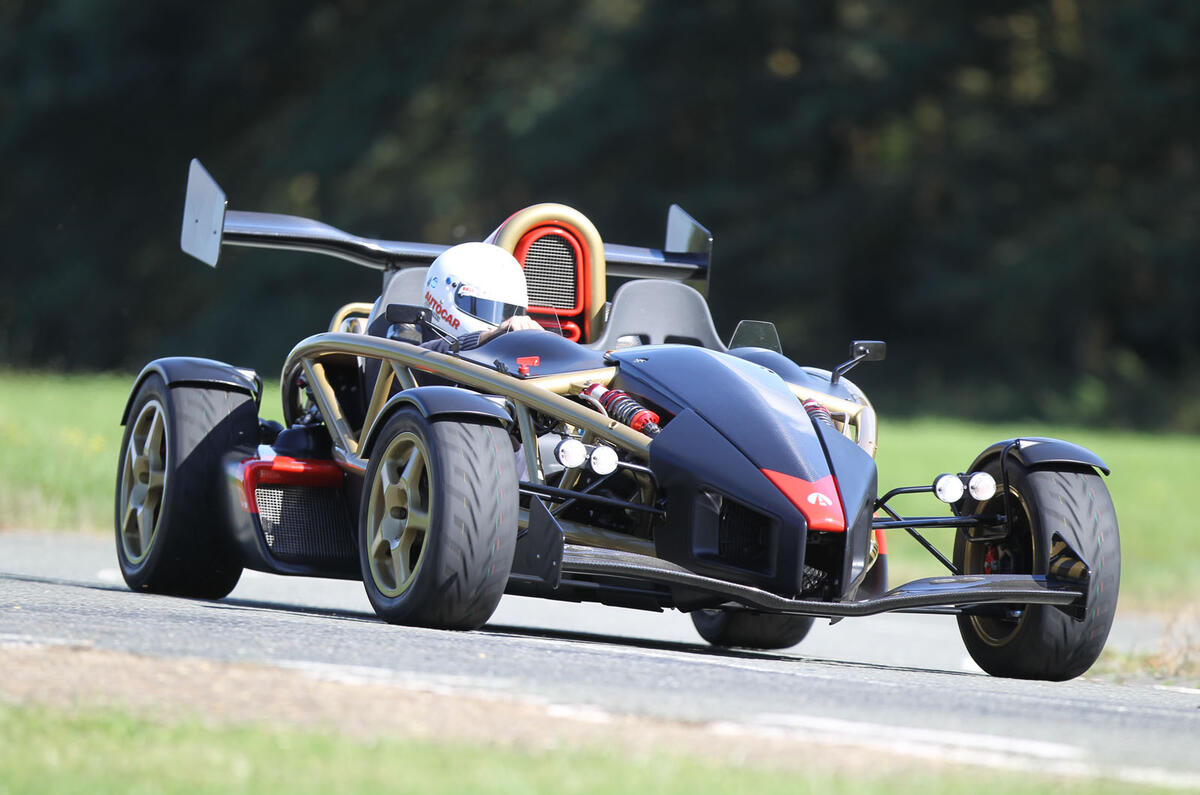What is it?
It’s the fastest road car I’ve ever driven. Come to think of it, it’s pretty much the fastest-accelerating production car anybody’s ever driven.
It’s the Ariel Atom V8 which, in place of a Honda-sourced VTEC engine at its back gets, as its name suggests, a V8 motor; of 3.0-litres. The engine started life a few years ago in the States with Suzuki bike internals but has been developed to the extent that it now wears Ariel branding.
It develops, oh you know, just the 475bhp in road trim, as tested here (500bhp in racing form). Even this trim has a good 175bhp more than the supercharged Atom – which I already thought was about as fast as you’d want one of these cars to go.
The Atom V8’s kerbweight is 550kg, so all done it makes 864bhp per tonne. For the record, an F3 car has about half that; a typical superbike will make over 700; a GP2 car will sneak over 900.
And a Bugatti Veyron? Previously the fastest-accelerating road car I’d driven, it has a mere 525 or so.
You’ll notice some serious aerodynamic addenda on the Atom V8, and carbon sidepods, one which houses the oil cooler, the other the air reservoir for the pneumatic gearshift. Yep, a pneumatically operated gearbox as you’d usually find on a Super 2000 rally car; it’s said to push upshifts through, clutchless, in somewhere between 20 and 50 milliseconds.
So the Atom is going to be terrifying, right? Not according to the blokes at Ariel, who say they’ve made it perfectly driveable. We’ll see.
What’s it like?
Absurd, of course; but, quite seriously, the V8 is as tame and docile as Ariel claims – should you want it to be.
It idles a touch lumpily, but throttle response is manageable. The low speed ride was also a touch grumbly on our test version but the engine pulls cleanly at all revs. You do this for a while – at least, I did – because you want to get used to it; you want to feel comfortable before you unleash the full 800-plus bhp per tonne.
You need the clutch to pull away but, thereafter, so long as you’ve got around 10 per cent of throttle applied, you can leave the left pedal alone and pull through a super-fast, super-smooth upshift via the diddy, carbonfibre paddles behind the gearlever.
And when you do give the Atom V8 the beans? Really, there’s nothing else quite like it. It’s a cliché to say a car is ‘superbike fast’ – even for very quick road cars like a Murciélago or the Atom 300. Bikes weigh so little they’ll also have an acceleration advantage. Except here; the Atom is a car that will show even a proper bike its tailpipes, not just in braking or cornering, but in straight-line acceleration, too.
Ariel hopes the Atom V8 will reach 0-60mph in comfortably under 2.5sec and 100mph in 5.4; and I believe it. First gear runs to over 60mph and upshifts are just stupendously fast – there’s no noticeable let-up in torque to the wheels; you’d swear it was a twin-clutch gearbox if you didn’t know better. The noise (it has a flat-plane crank) is electrifying, too. Gearing has recently been changed to make the top speed 170mph, at which point the V8 will run on its limiter.






























Join the debate
Add your comment
Re: Ariel Atom V8
Agree with most of this statement apart from the last paragraph. Wider tyres make no difference to the size of the contact patch. so the weight per unit of area is not decreased, its the same. Let me explain. If for example you had a car weighing 1000lb with even weight distribution then each tyre would have to support 250lb. If you put 25lb of pressure in said tyre it would have a contact patch of 10 square inches. If you then put a wider tyre on with the same pressure then the contact patch area stays exactly the same but it changes shape, becoming wider laterally but thinner longitudinally. The advantage therefore of wider tyres is that because there is less flex in the tyre to achieve the same area of contact patch less heat is generated so a softer compound can be used. This is the true reason wider tyres have more grip.
Re: Ariel Atom V8
I'm sure I read a short piece in a car magazine recently which quoted from a bike magazine article in which a Veyron was up against a BMW sports bike (the article said the BMW was regarded as the best all round sports bike).
IIRC, the points made were...
The 2 were pretty much neck and neck to 100mph
Above 130mph the Veyron just disappeared
The Veyron was much better under brakes, carried more speed mid corner and was able to deploy more of it's power exiting the corner.
Obviously a bit of a price difference though!
Re: Ariel Atom V8
Veyron SS will hit the ton in 4.6 while listening to Zepplin...